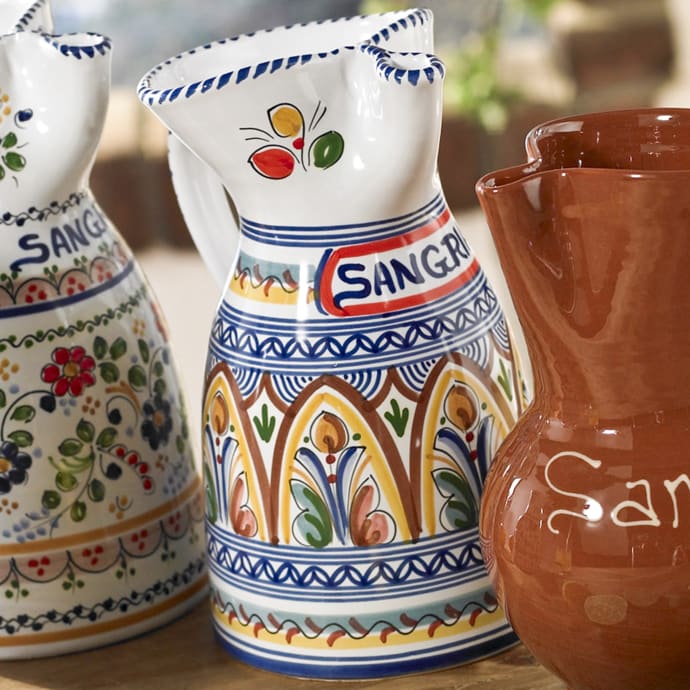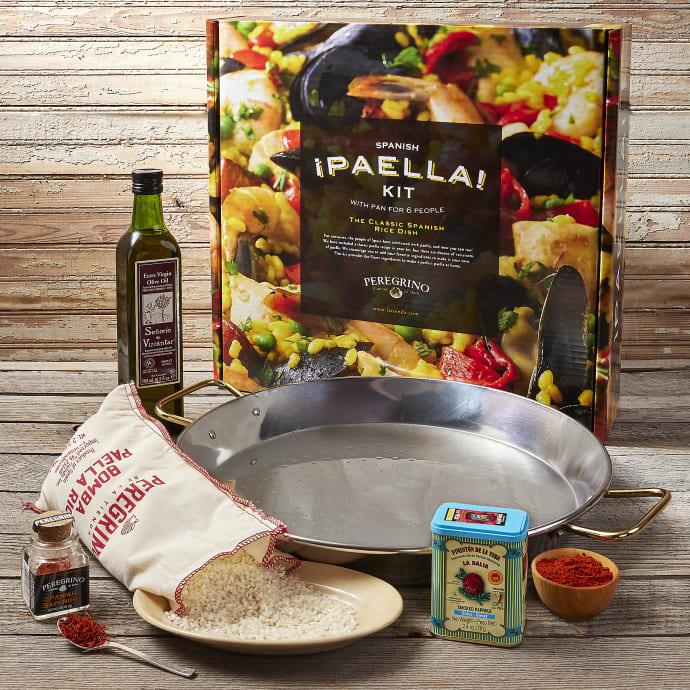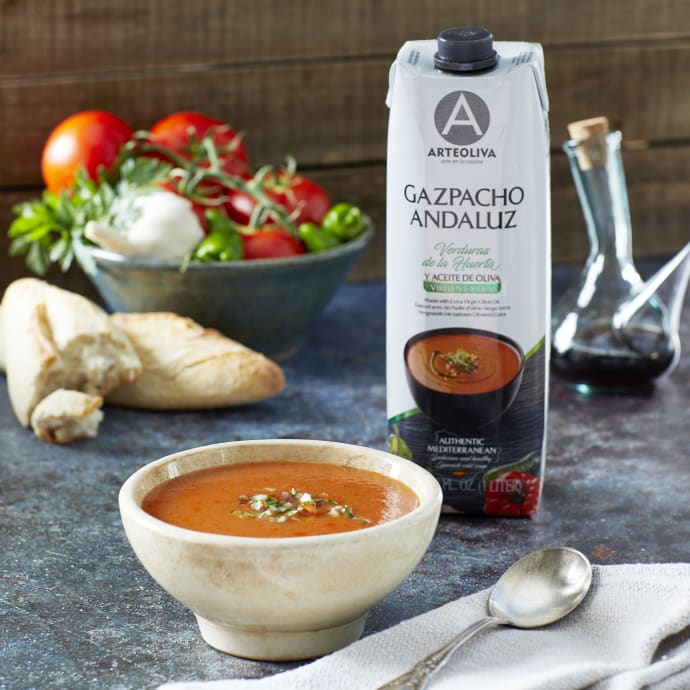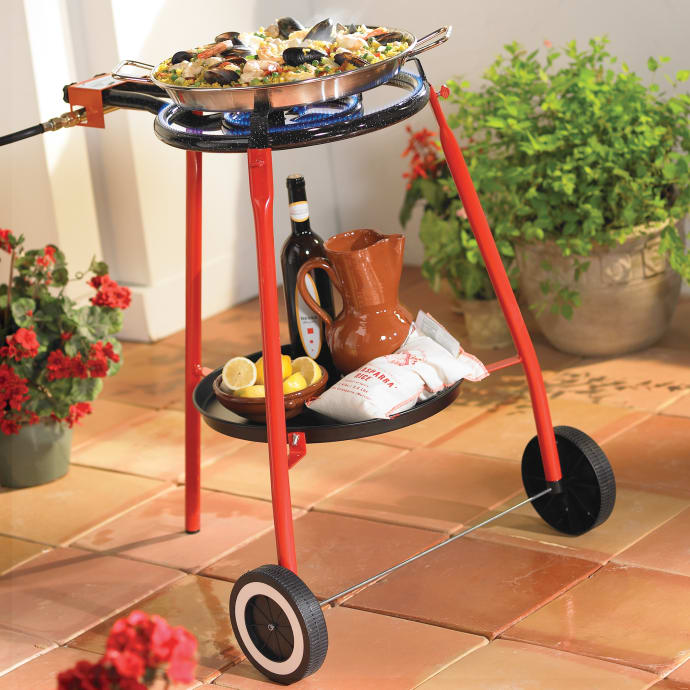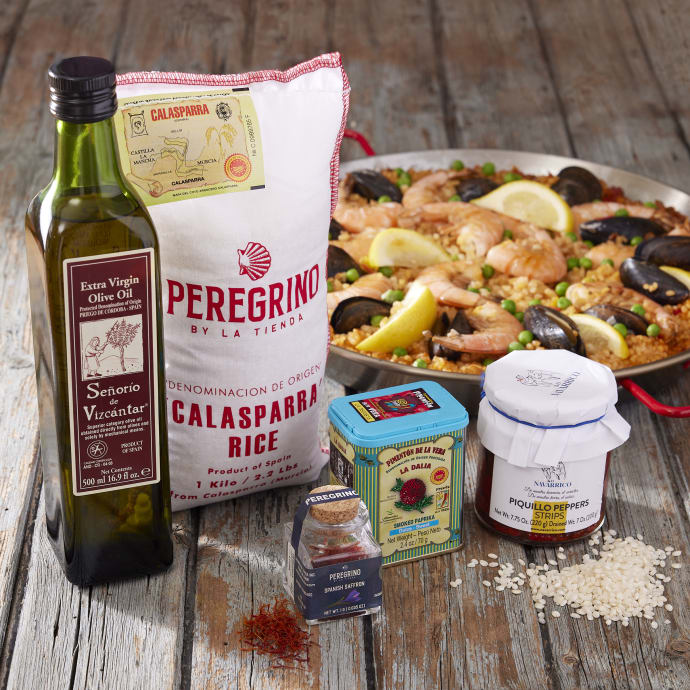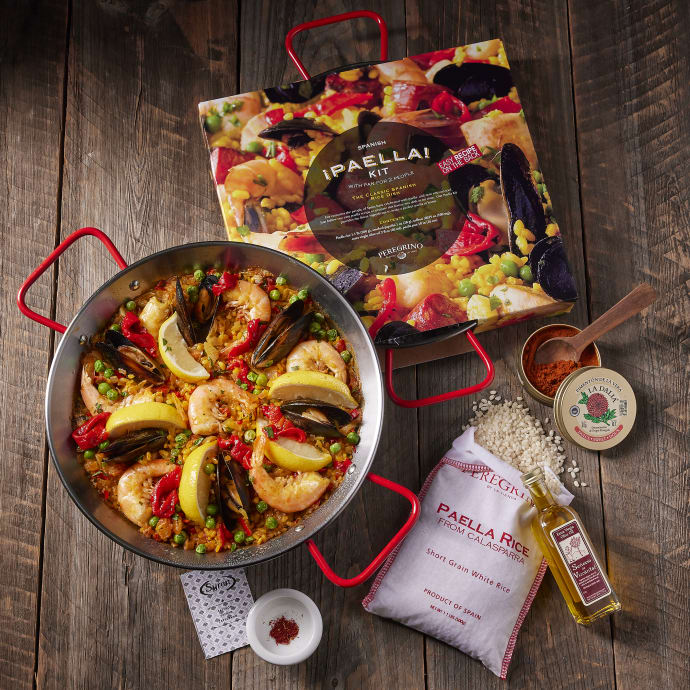
Life & Style - Cooking
St. Louis Today
-
August 3, 2005
They reign in Spain
Georgina Gustin Of the Post-Dispatch
If you’re thinking of putting together a Spanish summer feast, you might want to master a few key words, and preferably say them with authority and flourish: gazpacho, paella, sangria and flan.
Make sure you roll the “r” in sangria and shorten the “a” in flan. Exclaim the words with Castillian flair.
Everything will taste better.
Of course, actually making the food is important, too, and paella, the rice-based, unofficial national dish of Spain, will require a little bit of practice (or luck) to get just right. In Spain, where paella (pronounced pie-AY-ya) is the traditional Sunday meal, cooks have argued for generations about the best route to achieving perfection. But don’t be intimidated — the results are amazing, even if you’re a beginner, and are about as beautiful and celebratory as food can be. You’ll even gain a few words in the process.
The dish is cooked in a low-rimmed, round pan called a paellera, made traditionally of thin carbon steel that conducts heat quickly. A mixture of onions, garlic and tomato, called sofrito, serves as the flavor base. When the rice is cooked, the heat gets cranked up under the pan, so the rice starts crackling and turning brown, forming a caramelized bottom crust. Achieving that crust — called socarrat, and considered by some Spaniards to be an aphrodisiac — is the ultimate goal of the paella cook.
I remember first eating paella as a child at an old Spanish roadside inn, not far from the Mediterranean coast. We sat in a white-stucco-walled courtyard at tables covered in white cloths. The paella came out of the kitchen, carried like a vibrant disc, colored orange with saffron-infused broth and studded with black mussels.
I’ve made a couple of paellas since then, but they were never as good, or even close, with nothing resembling the socarrat. It was only recently that one of my brothers, who’s a former chef, told me about a Web site where you can order authentic paella pans from Spain. I was inspired by his efforts to plop down $54 for a 22-inch paella pan and try for the elusive crust myself.
Paella pans come as small as 10 inches to serve one to two people and as large as 52 inches, to serve up to 200. The one I bought serves seven to 10 people, so I decided to build an evening around the paella and invite a few friends to sample my efforts.
The menu, I thought, should be of Spanish classics — the tastes I associate with Spain.
I started by making flan, the popular custard dessert with a caramelized sugar topping. Flan needs to chill in the refrigerator for at least four hours and can stay in for two days, so it’s ideal if you want to get dessert out of the way. I chose an untraditional recipe, flavored with lemon and cinnamon.
After I put the flan in the refrigerator, I started on the gazpacho, the famed cold vegetable soup of southern Spain.
Food historians attribute gazpacho’s origins to the Andalusia region, dating to a time when much of Spain was part of the Islamic world.
Gazpacho originally was a poor man’s soup, made of bread, water and oil; through time, it morphed into today’s “liquid salad” of tomatoes, garlic, peppers, onions, cucumber, oil, vinegar and bread crumbs or croutons. There are hundreds of permutations of gazpacho. I used one that I consider the traditional gazpacho, loading it with croutons and avocado for garnish.
I chose a recipe for seafood paella and added chicken to the mix. Before everyone arrived, I started the prep work, peeling garlic, grating onion and tomato and creating a broth from shrimp shells. I sautéed the chicken thighs (which work better than chicken breasts for paella, I was told) and the shrimp and scallops in the paella pan, then set them aside.
My husband made the sangria, the deceptively alcoholic wine-and-fruit potion that can sneak up on you if you’re not careful. We chose a recipe with brandy and sparkling water, which brightened the taste a bit, as sangria can get a little syrupy and cloying.
When our guests arrived, we poured the sangria and put out a plate of aged Manchego, a nutty sheep’s milk cheese, and Serrano ham, a robust cured ham that’s something like prosciutto. The combination of Spanish specialties is classic.
As our friends stood around our kitchen, I worked on finishing the paella.
Versions of paella are limitless, and paella cooks each have their own interpretations. But ultimately there is no single right way. You can throw just about anything in a paella that you think suits it.
The one essential element is a short or medium-grain rice that absorbs flavors better than long-grain varieties. The ultimate variety is Spanish Bomba rice, a short-grain rice that is said to soak up flavors more than other types, but any medium-grain rice can work well.
First, I sautéed grated onion, tomato and garlic for about 15 minutes, until the mixture turned almost maroon in color. I then sautéed the rice for a couple of minutes before adding the broth. I shook the pan to even out the rice, which barely covered the bottom of the pan, and after about 20 minutes, when the broth was absorbed, I turned up the heat, keeping my fingers crossed during the final, critical two minutes.
(I’ve cooked paella on a grill, gas burners and electric stovetop, and I think a grill works best because the heat source is largest and is distributed evenly. You can throw a few herbs, such as rosemary or thyme, on the grill, which will infuse the paella with flavor.)
My husband poured a couple of bottles of French rosé, which we thought would go nicely with the gazpacho and the paella, while I waited for the rice to crackle. One of our friends came over to the stove, and we both bent down, putting our ears next to the pan.
I got crackle. Then a burning smell. I pulled the pan off the heat.
We sat down to our gazpacho and, a few minutes later, I served up the paella, diving into the rice with a spatula. I hit the bottom of the pan and started scraping little bits of burnt rice turned up, but so did the occasional sheet of perfect caramelized crust.
We sat around our dining room table and dove in, finishing an entire 22 inches of paella with ease. Then we rounded the night out with some nicely inverted flans, dripping with caramel sauce.
Success! Or, as they might say on the Iberian peninsula: Exito!
======================
... www.tienda.com, has pans and a wide selection of Spanish specialties, including hams, cheeses, saffron, almonds, olives and Bomba rice.
Georgina Gustin Of the Post-Dispatch
If you’re thinking of putting together a Spanish summer feast, you might want to master a few key words, and preferably say them with authority and flourish: gazpacho, paella, sangria and flan.
Make sure you roll the “r” in sangria and shorten the “a” in flan. Exclaim the words with Castillian flair.
Everything will taste better.
Of course, actually making the food is important, too, and paella, the rice-based, unofficial national dish of Spain, will require a little bit of practice (or luck) to get just right. In Spain, where paella (pronounced pie-AY-ya) is the traditional Sunday meal, cooks have argued for generations about the best route to achieving perfection. But don’t be intimidated — the results are amazing, even if you’re a beginner, and are about as beautiful and celebratory as food can be. You’ll even gain a few words in the process.
The dish is cooked in a low-rimmed, round pan called a paellera, made traditionally of thin carbon steel that conducts heat quickly. A mixture of onions, garlic and tomato, called sofrito, serves as the flavor base. When the rice is cooked, the heat gets cranked up under the pan, so the rice starts crackling and turning brown, forming a caramelized bottom crust. Achieving that crust — called socarrat, and considered by some Spaniards to be an aphrodisiac — is the ultimate goal of the paella cook.
I remember first eating paella as a child at an old Spanish roadside inn, not far from the Mediterranean coast. We sat in a white-stucco-walled courtyard at tables covered in white cloths. The paella came out of the kitchen, carried like a vibrant disc, colored orange with saffron-infused broth and studded with black mussels.
I’ve made a couple of paellas since then, but they were never as good, or even close, with nothing resembling the socarrat. It was only recently that one of my brothers, who’s a former chef, told me about a Web site where you can order authentic paella pans from Spain. I was inspired by his efforts to plop down $54 for a 22-inch paella pan and try for the elusive crust myself.
Paella pans come as small as 10 inches to serve one to two people and as large as 52 inches, to serve up to 200. The one I bought serves seven to 10 people, so I decided to build an evening around the paella and invite a few friends to sample my efforts.
The menu, I thought, should be of Spanish classics — the tastes I associate with Spain.
I started by making flan, the popular custard dessert with a caramelized sugar topping. Flan needs to chill in the refrigerator for at least four hours and can stay in for two days, so it’s ideal if you want to get dessert out of the way. I chose an untraditional recipe, flavored with lemon and cinnamon.
After I put the flan in the refrigerator, I started on the gazpacho, the famed cold vegetable soup of southern Spain.
Food historians attribute gazpacho’s origins to the Andalusia region, dating to a time when much of Spain was part of the Islamic world.
Gazpacho originally was a poor man’s soup, made of bread, water and oil; through time, it morphed into today’s “liquid salad” of tomatoes, garlic, peppers, onions, cucumber, oil, vinegar and bread crumbs or croutons. There are hundreds of permutations of gazpacho. I used one that I consider the traditional gazpacho, loading it with croutons and avocado for garnish.
I chose a recipe for seafood paella and added chicken to the mix. Before everyone arrived, I started the prep work, peeling garlic, grating onion and tomato and creating a broth from shrimp shells. I sautéed the chicken thighs (which work better than chicken breasts for paella, I was told) and the shrimp and scallops in the paella pan, then set them aside.
My husband made the sangria, the deceptively alcoholic wine-and-fruit potion that can sneak up on you if you’re not careful. We chose a recipe with brandy and sparkling water, which brightened the taste a bit, as sangria can get a little syrupy and cloying.
When our guests arrived, we poured the sangria and put out a plate of aged Manchego, a nutty sheep’s milk cheese, and Serrano ham, a robust cured ham that’s something like prosciutto. The combination of Spanish specialties is classic.
As our friends stood around our kitchen, I worked on finishing the paella.
Versions of paella are limitless, and paella cooks each have their own interpretations. But ultimately there is no single right way. You can throw just about anything in a paella that you think suits it.
The one essential element is a short or medium-grain rice that absorbs flavors better than long-grain varieties. The ultimate variety is Spanish Bomba rice, a short-grain rice that is said to soak up flavors more than other types, but any medium-grain rice can work well.
First, I sautéed grated onion, tomato and garlic for about 15 minutes, until the mixture turned almost maroon in color. I then sautéed the rice for a couple of minutes before adding the broth. I shook the pan to even out the rice, which barely covered the bottom of the pan, and after about 20 minutes, when the broth was absorbed, I turned up the heat, keeping my fingers crossed during the final, critical two minutes.
(I’ve cooked paella on a grill, gas burners and electric stovetop, and I think a grill works best because the heat source is largest and is distributed evenly. You can throw a few herbs, such as rosemary or thyme, on the grill, which will infuse the paella with flavor.)
My husband poured a couple of bottles of French rosé, which we thought would go nicely with the gazpacho and the paella, while I waited for the rice to crackle. One of our friends came over to the stove, and we both bent down, putting our ears next to the pan.
I got crackle. Then a burning smell. I pulled the pan off the heat.
We sat down to our gazpacho and, a few minutes later, I served up the paella, diving into the rice with a spatula. I hit the bottom of the pan and started scraping little bits of burnt rice turned up, but so did the occasional sheet of perfect caramelized crust.
We sat around our dining room table and dove in, finishing an entire 22 inches of paella with ease. Then we rounded the night out with some nicely inverted flans, dripping with caramel sauce.
Success! Or, as they might say on the Iberian peninsula: Exito!
======================
... www.tienda.com, has pans and a wide selection of Spanish specialties, including hams, cheeses, saffron, almonds, olives and Bomba rice.
Other Press
Holiday Gift Guide 2024: The Finest Spanish Olive Oils For A Taste Of Spain
Forbes
-
November 26, 2024
A trio of savory snacks to enjoy this fall
Atlanta Journal-Counstitution
-
November 1, 2024
The 15 Best Gifts for People Who Love Food
Wirecutter
-
October 23, 2024
The 48 Best Gifts for Dads
Wirecutter
-
October 16, 2024
Featured Products

Hand-Painted Ceramic Sangría Pitcher
CM-07
(20)
$49.00$49.00

Deluxe Paella Kit with Stainless Pan by Peregrino
PA-07
(6)
$199.00$199.00
 SALE
SALEGazpacho Andaluz with Extra Virgin Olive Oil
SU-29
(35)
2 for $19.00 $15.00

Paella Burner with Rolling Stand and FREE 17 inch Pan
PB-06B
(7)
$299.00$299.00
 BEST SELLER
BEST SELLEREssential Paella Ingredients
PA-05
(31)
$69.00$69.00

Mediterranean Blue Terra Cotta Sangría Pitcher
CA-33
$29.00$29.00
 SHIPS FREE
SHIPS FREEMini Paella Kit with Pan in Gift Box by Peregrino - FREE SHIPPING!
PA-10
(32)
$69.00$69.00

